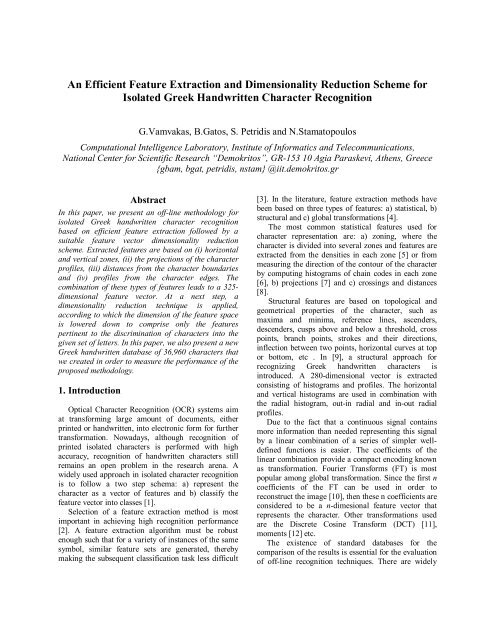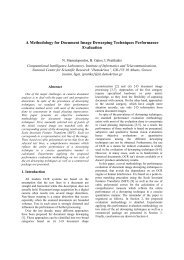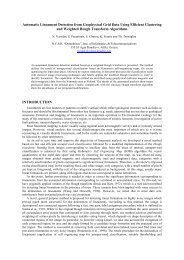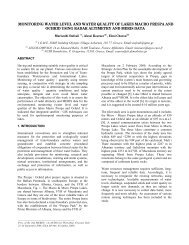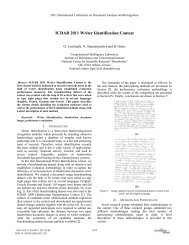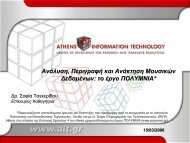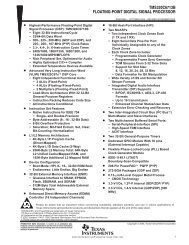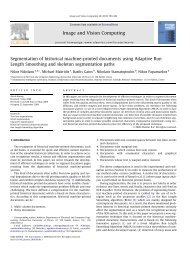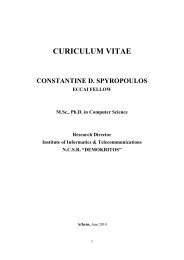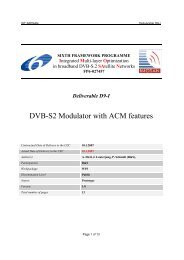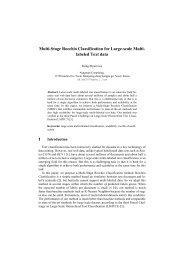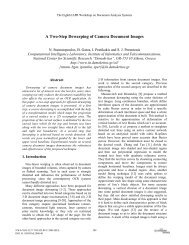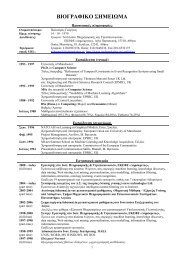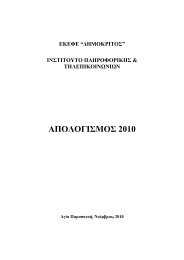An Efficient Feature Extraction and Dimensionality Reduction ...
An Efficient Feature Extraction and Dimensionality Reduction ...
An Efficient Feature Extraction and Dimensionality Reduction ...
- No tags were found...
Create successful ePaper yourself
Turn your PDF publications into a flip-book with our unique Google optimized e-Paper software.
<strong>An</strong> <strong>Efficient</strong> <strong>Feature</strong> <strong>Extraction</strong> <strong>and</strong> <strong>Dimensionality</strong> <strong>Reduction</strong> Scheme forIsolated Greek H<strong>and</strong>written Character RecognitionG.Vamvakas, B.Gatos, S. Petridis <strong>and</strong> N.StamatopoulosComputational Intelligence Laboratory, Institute of Informatics <strong>and</strong> Telecommunications,National Center for Scientific Research “Demokritos”, GR-153 10 Agia Paraskevi, Athens, Greece{gbam, bgat, petridis, nstam} @iit.demokritos.gr(ED in the initial submission for double blind reviewAbstractIn this paper, we present an off-line methodology forisolated Greek h<strong>and</strong>written character recognitionbased on efficient feature extraction followed by asuitable feature vector dimensionality reductionscheme. Extracted features are based on (i) horizontal<strong>and</strong> vertical zones, (ii) the projections of the characterprofiles, (iii) distances from the character boundaries<strong>and</strong> (iv) profiles from the character edges. Thecombination of these types of features leads to a 325-dimensional feature vector. At a next step, adimensionality reduction technique is applied,according to which the dimension of the feature spaceis lowered down to comprise only the featurespertinent to the discrimination of characters into thegiven set of letters. In this paper, we also present a newGreek h<strong>and</strong>written database of 36,960 characters thatwe created in order to measure the performance of theproposed methodology.1. IntroductionOptical Character Recognition (OCR) systems aimat transforming large amount of documents, eitherprinted or h<strong>and</strong>written, into electronic form for furthertransformation. Nowadays, although recognition ofprinted isolated characters is performed with highaccuracy, recognition of h<strong>and</strong>written characters stillremains an open problem in the research arena. Awidely used approach in isolated character recognitionis to follow a two step schema: a) represent thecharacter as a vector of features <strong>and</strong> b) classify thefeature vector into classes [1].Selection of a feature extraction method is mostimportant in achieving high recognition performance[2]. A feature extraction algorithm must be robustenough such that for a variety of instances of the samesymbol, similar feature sets are generated, therebymaking the subsequent classification task less difficult[3]. In the literature, feature extraction methods havebeen based on three types of features: a) statistical, b)structural <strong>and</strong> c) global transformations [4].The most common statistical features used forcharacter representation are: a) zoning, where thecharacter is divided into several zones <strong>and</strong> features areextracted from the densities in each zone [5] or frommeasuring the direction of the contour of the characterby computing histograms of chain codes in each zone[6], b) projections [7] <strong>and</strong> c) crossings <strong>and</strong> distances[8].Structural features are based on topological <strong>and</strong>geometrical properties of the character, such asmaxima <strong>and</strong> minima, reference lines, ascenders,descenders, cusps above <strong>and</strong> below a threshold, crosspoints, branch points, strokes <strong>and</strong> their directions,inflection between two points, horizontal curves at topor bottom, etc . In [9], a structural approach forrecognizing Greek h<strong>and</strong>written characters isintroduced. A 280-dimensional vector is extractedconsisting of histograms <strong>and</strong> profiles. The horizontal<strong>and</strong> vertical histograms are used in combination withthe radial histogram, out-in radial <strong>and</strong> in-out radialprofiles.Due to the fact that a continuous signal containsmore information than needed representing this signalby a linear combination of a series of simpler welldefinedfunctions is easier. The coefficients of thelinear combination provide a compact encoding knownas transformation. Fourier Transforms (FT) is mostpopular among global transformation. Since the first ncoefficients of the FT can be used in order toreconstruct the image [10], then these n coefficients areconsidered to be a n-dimesional feature vector thatrepresents the character. Other transformations usedare the Discrete Cosine Transform (DCT) [11],moments [12] etc.The existence of st<strong>and</strong>ard databases for thecomparison of the results is essential for the evaluationof off-line recognition techniques. There are widely
used databases for h<strong>and</strong>writing recognition, such asNIST [13], CEDAR [14], CENPARMI [15] <strong>and</strong>UNIPEN [16]. As far as Greek characters areconcerned the only database one can find in theliterature is the GRUHD database [17], which consistsof Greek characters, text, digits <strong>and</strong> symbols inunconstrained h<strong>and</strong>writing mode.In this paper we present a database consisting of36,960 isolated Greek H<strong>and</strong>written Characters.Furthermore, an off-line OCR methodology for theseletters is proposed based on a feature extractionscheme followed by a suitable dimensionalityreduction step. The remaining of the paper is organizedas follows. In Sections 2 <strong>and</strong> 3 the data acquisitionprocedure <strong>and</strong> the proposed methodology are presentedrespectively. Experimental results are discussed inSection 4 <strong>and</strong> finally conclusions are drawn in Section5.2. Greek H<strong>and</strong>written Character DatabaseThe database comprises samples of 56 Greekh<strong>and</strong>written characters (24 uppercase, 24 lowercase,the final “ς” <strong>and</strong> the accented vowels “ά”, “έ”, “ή”, “ί”, “ύ”, “ό”, “ώ ”) written by 132 Greek writers. Everywriter contributed 5 samples of each letter, thus resultingin a database of 660 variations of each letter <strong>and</strong> anoverall of 36,960 isolated labelled character samples.width of the line. A likewise procedure is followed fordetecting the vertical lines.Notice that, due to the fact that the form may beslightly skewed, a problem that can occur is that a linemay not be detected, as shown in Fig.2.Figure 2. Error in line detectionSpecifically, if D min is the minimum number ofconsecutive black pixels <strong>and</strong> d is the expected width ofthe line, then, the maximum angle of skew, for whichthe line can be detected, is: φ max = tan -1 (d/D min ).Once lines detection has been completed, we proceedinto determining the cells, in which characters arewritten. A simple method would be to define the coordinatesof the cells as lines <strong>and</strong> columns intersections.However, if the lines are slightly skewed, then the coordinatesof the intersections are incorrectly calculated,which fact may have severe effects for the extraction ofthe character from the cell (i.e. part of the character,which will be located at the boundaries of the defined“cell”, can be fragmented). To avoid this problem, weredefine the co-ordinates for every cell separately.Figure 1. Sample of the forms usedCollection of characters has been facilitated byrequesting writers to fill specially crafted forms, asshown in Fig.1, afterward converted to binary imageswith the use of a scanner. In order to segment the forminto cells containing the characters, detection ofhorizontal <strong>and</strong> vertical lines present in the forms wasnecessary. The form is scanned horizontally <strong>and</strong> whenthe first black pixel is detected we calculate the numberconsecutive black pixels. If the number exceeds apredefined number D min then it is presumed that thestart (Y s ) of a line has been detected. The end (Y e ) ofthe line is calculated as Y s +d where d is the expectedFigure 3. Redefinition of the co-ordinates for cellextractionConsider two consecutive horizontallines, H1( Ys1, Ye1), H2( Ys2, Ye2), <strong>and</strong> two consecutivevertical lines, V1( Xs1, Xe1)<strong>and</strong> V2( Xs2, Xe2)( Fig. 3). Todefine the cell formed by these lines we start from thecentre of the initial cell with vertical offset mid:Ys2−Ye1mid = Ye1+ (1)2<strong>and</strong> scanning upwards until a line Yc1is detected asfollows:f( x, Yc1) = 1 where x1 ≤ x ≤ x2, x2 - x1 ≥ L (2)min<strong>and</strong> mid ≥Y ≥Yc1 e1Similarly downwards we detect a line Yc2as follows:
f( x, Y ) = 1 where x ≤ x≤ x , x - x ≥ L<strong>and</strong> mid ≤Y ≤Yc2 1 2 2 1 minc2 s2(3)where L min is a predefined number of consecutive blackpixels used to find the lines of a cell. So the coordinatesof the cell are Y c1 , Y c2 , X e1 , X s2 .The bounding box of the character inside the celldefines the character image that will be stored in thedatabase.For all blocks formed we calculate the area of theupper/lower character profiles. Fig. 5c illustrates thefeatures extracted from a character image usingupper/lower character profiles.Similarly, we extract the features based on left/rightcharacter profiles (Fig. 6).3. <strong>Feature</strong> <strong>Extraction</strong> MethodBefore the feature extraction algorithm takes place,we first normalize all binary character images to a ΝxNmatrix with respecting the original aspect ratio.3.1. <strong>Feature</strong> <strong>Extraction</strong>In our approach, we employ four types of features.The first set of features is based on zones. The image isdivided into horizontal <strong>and</strong> vertical zones, <strong>and</strong> for eachzone we calculate the density of the character pixels(Fig. 4).(a) (b) (c)Figure 6. <strong>Feature</strong> extraction of a character imagebased on left <strong>and</strong> right character profile projections. (a)The normalized character image. (b) Left <strong>and</strong> rightcharacter profiles. (c) The extracted features. Darkersquares indicate higher density of zone pixels.The third feature set is based on the distances [8] ofthe first image pixel detected from the upper <strong>and</strong> lowerboundaries of the image, scanning along equallyspaced vertical lines as well as from the left <strong>and</strong> rightboundaries scanning along equally spaced horizontallines (Fig .7)(a) (b)Figure 4. <strong>Feature</strong> extraction of a character imagebased on zones. (a) The normalized character image.(b) <strong>Feature</strong>s based on zones. Darker squares indicatehigher density of character pixels.In the second type of features, the area that isformed from the projections of the upper <strong>and</strong> lower aswell as of the left <strong>and</strong> right character profiles iscalculated. Firstly, the center mass (x t ,y t ) of thecharacter image is found.Upper/lower profiles are computed by considering,for each image column, the distance between thehorizontal line y=y t <strong>and</strong> the closest pixel to theupper/lower boundary of the character image (Fig. 5b).(a)(b)Figure 7. <strong>Feature</strong> extraction of a character imagebased on distances. (a) The normalized characterimage. (b) A sample distance from the right boundary.The forth set, calculates the profiles of the characterfrom the upper, lower, left <strong>and</strong> right boundaries of theimage [7], as shown in Fig. 8. The profile counts thenumber of pixels between the edges of the image <strong>and</strong>the contour of the character. These features are usedbecause they describe well the external shape of thecharacters.(a) (b) (c)Figure 5. <strong>Feature</strong> extraction of a character imagebased on upper <strong>and</strong> lower character profile projections.(a) The normalized character image. (b) Upper <strong>and</strong>lower character profiles. (c) The extracted features.Darker squares indicate higher density of zone pixels.This ends up in two zones (upper, lower) dependingon y t . Then both zones are divided into vertical blocks.Figure 8. <strong>Feature</strong>s extraction of the character imagebased on profiles.
3.2. <strong>Dimensionality</strong> reductionOnce the character has been represented as a featurevector, a classification rule has to be defined in order toclassify it into one among the letters. Even thoughmachine learning literature provides us a wide choiceof learning algorithms to construct classifiers based ontraining data, these have limited capabilities toconstruct the optimal one, depending on particularitiesof the distributions of the classes in the feature space.<strong>An</strong> important such limitation, evident to algorithmsgiving each feature direction equal importance,concerns the sensitivity to the number of featurescomprising the feature vector. These classifiers, suchas the K Nearest Neighbors (K-NN) [18] <strong>and</strong> theSupport Vector Machine (SVM) using the Radial BasisFunction (RBF) kernel [19], tend to be disturbed bynoisy features, i.e. features that contain no usefulinformation concerning the separability of classes.To that end, our methodology for characterrecognition also considered a dimensionality reductionstep, according to which the dimension of the featurespace, engendered by the features extracted using themethodology described in section 3.1, is lowered downto comprise only the features pertinent to thediscrimination of characters into the given set ofletters. In particular, we employed the LinearDiscriminant <strong>An</strong>alysis (LDA) method [19], accordingto which the most significant linear features are thosewhere the samples distribution has important overallvariance while the samples per class distributions havesmall variance. Formally, this criterion is representedasTw Cov(X ) w(4)LDA( w)=Tw E [ Cov(X | c)]wcwhere w represents a linear combination of the originalfeatures, X the original feature vector, c the class, Covis a the covariance matrix that has to be estimated fromthe samples <strong>and</strong> E c is the expectation in respect to theclasses. It turns out that finding the linear features thatmaximize the LDA criterion comes down to solving ageneralized eigenvalue/eigenvector problem <strong>and</strong>keeping the eigenvectors that have greater eigenvalues.Moreover, the ratio of the sum of the eigenvalues keptto the overall eigenvalues sum provides as an index ofquality of the feature subspace kept.4. Experimental ResultsFor our experiments the Greek h<strong>and</strong>writtencharacter database was used. After size normalizationsome characters such as the uppercase “Ο” <strong>and</strong> thelowercase “o” are considered to be the same. So forhaving meaningful results we merged these two classesinto one, by r<strong>and</strong>omly selecting 660 characters formboth classes. This was done to a total of 10 pair ofclasses, as shown in Table 1. This concluded in having46 classes each one containing 660 patterns <strong>and</strong> thedatabase now has 46x660=30,360 characters. Moreover,1/5 of each class was used for testing <strong>and</strong> the 4/5 fortraining.Table 1. Merged ClassesUppercase Lowercase1 Ε ε2 Θ θ3 Κ κ4 Ο ο5 Π π6 Ρ ρ7 Τ τ8 Φ φ9 Χ χ10 Ψ ψAs it has already been described in section 3 wehave used a size normalization step before featureextraction. During this step, the size of the normalizedcharacter images used is x max =60 <strong>and</strong> y max =60. In thecase of features based on zones, the character image isdivided into 5 horizontal <strong>and</strong> 5 vertical zones forming atotal of 25 blocks with size 12x12 (see Fig. 4).Therefore, the number of features based on zones is 25.In the case of features based on character (upper/lower)profile projections the image is divided into 10 verticalzones (see Fig. 5). Similarly, the normalized image isdivided into 10 horizontal zones (see Fig. 6).Therefore, the total number of features based on profileprojections is 40. For the third type of features thedistances from upper <strong>and</strong> lower boundaries <strong>and</strong> fromleft <strong>and</strong> right boundaries are calculated along 5 vertical<strong>and</strong> along 5 horizontal lines respectively (see Fig.7).So, the number of corresponding features is 20.Finally, since the character image is normalized to a60x60 matrix, the total number of features extractedfrom the profiles is 4x60=240 (see Fig. 8). Combiningall the above feature extraction schemes led to a 325-dimensional feature vector.For the classification step three well knownclassifiers were used; the Naïve Bayes [20], the k-NN<strong>and</strong> the SVM. As shown in Fig. 9 their performancedepends on the number of features used. Moreover, allthree classifiers perform better when they useapproximately 50 out of 325 features. Finally, the SVMseems to achieve considerable higher levels ofrecognition accuracy than the other two classifiers. Thebest performance (92,05 %) is attained with the SVMusing 40 features.
Figure 9. Classification accuracy for all threeclassifiers depending on the number of features used.5. ConclusionsIn this paper, we propose an off-line OCRmethodology for isolated Greek h<strong>and</strong>written charactersbased on feature extraction scheme followed by adimensionality reduction step, which seems to improvethe recognition accuracy.Our future research will focus on exploiting newfeatures as well as fusion methods to further improveas well as on the creation of new hierarchicalclassification schemes based on rules extracted afterexamining the corresponding confusion matrix.AcknowledgementsThis research is carried out within the framework ofthe Greek Ministry of Research funded R&D projectPOLYTIMO [21] which aims to process <strong>and</strong> provideaccess to the content of valuable historical books <strong>and</strong>h<strong>and</strong>written manuscripts.References[1] A. S. Britto, R. Sabourin, F. Bortolozzi, C. Y. Suen,“Foreground <strong>and</strong> Background Information in an HMM-BasedMethod for Recognition of Isolated Characters <strong>and</strong> NumeralStrings”, 9th International Workshop on Frontiers inH<strong>and</strong>writing Recognition (IWFHR-9), 2004, pp. 371-376.[2]O. D. Trier, A. K. Jain, T.Taxt , “<strong>Feature</strong>s <strong>Extraction</strong>Methods for Character Recognition – A Survey”, PatternRecognition, 1996, Vol.29, No.4, pp. 641-662.[3] J. A. Fitzgerald, F. Geiselbrechtinger, <strong>and</strong> T. Kechadi,“Application of Fuzzy Logic to Online Recognition ofH<strong>and</strong>written Symbols”, 9th International Workshop onFrontiers in H<strong>and</strong>writing Recognition (IWFHR 9), 2004, pp.395- 400.[4] N. Arica <strong>and</strong> F. Yarman-Vural, “<strong>An</strong> Overview ofCharacter Recognition Focused on Off-line H<strong>and</strong>writing”,IEEE Transactions on Systems, Man, <strong>and</strong> Cybernetics, PartC: Applications <strong>and</strong> Reviews, 2001, 31(2), pp. 216 - 233.[5] Luiz S. Oliveira, F. Bortolozzi, C.Y.Suen, “AutomaticRecognition of H<strong>and</strong>written Numerical Strings: ARecognition <strong>and</strong> Verification Strategy”, IEEE Transactionson Pattern Recognition <strong>and</strong> Machine Intelligence, 2001, Vol.24, No. 11, pp. 1448-1456.[6] K. M. Mohiuddin <strong>and</strong> J. Mao, “A Comprehensive Studyof Different Classifiers for H<strong>and</strong>printed CharacterRecognition.” Pattern Recognition, Practice IV, 1994, pp.437- 448.[7]A. L. Koerich, “Unconstrained H<strong>and</strong>written CharacterRecognition Using Different Classification Strategies.”International Workshop on Artificial Neural Networks inPattern Recognition (ANNPR), 2003.[8] J. H. Kim, K. K. Kim, C. Y. Suen, “Hybrid Schemes OfHomogeneous <strong>and</strong> Heterogeneous Classifiers for CursiveWord Recognition”, 7 th International Workshop on Frontiersin H<strong>and</strong>writing Recognition, Amsterdam, 2000, pp 433 - 442.[9] E. Kavallieratou, N. Fotakis, G Kokkinakis, “H<strong>and</strong>writtenCharacter Recognition Based on Structural Characteristics”,ICPR, 16 th International Conference on Pattern Recognition(ICPR'02), 2002, pp. 139-142.[10] Kuhl, F.P., Giardina, “Elliptic Fourier features of aclosed contour”, Comput. Vis. Graphics Image Process. 18,1982, pp 236-258.[11] R. C. Gonzalez, R. E. Woods, “Digital ImageProcessing, Second Edition”, Prentice Hall, 2002.[12] Hu, “Visual pattern recognition by moment invariants”.In IRE Trans. Inf. Theory 8, 1962, pp. 179-187.[13] Wilkinson, J. Geist, S. Janet, P. Grother, C. Burges, R.Creecy, B. Hammond, J.Hull, N. Larsen, T. Vogl, <strong>and</strong> C.Wilson. The first census optical character recognitionsystems conf. #NISTIR 4912, The U.S. Bureau of Census<strong>and</strong> the National Institute of St<strong>and</strong>ards <strong>and</strong> Technology,Gaithersburg, MD, 1992.[14]Hull, “A database for h<strong>and</strong>written text recognitionresearch”, IEEE Trans. on Pattern <strong>An</strong>alysis <strong>and</strong> MachineIntelligence, 1994, Volume 16, Issue 5, pp. 550 – 554.[15] C. Y. Suen, C. Nadal, R. Legault, T. Mai, <strong>and</strong> L. Lam ,“Computer recognition of unconstrained h<strong>and</strong>writtennumerals”, Proc. of the IEEE, 1992, Volume 7, Issue 80,pp.1162-1180.[16] I. Guyon, L. Schomaker, R. Plamondon, M. Liberman,<strong>and</strong> S. Janet, “Unipen project of on-line data exchange <strong>and</strong>benchmarks”, Proc. of the 12th IAPR Int. Conf on PatternRecognition, Jerusalem, Israel, Oct. 1994, pp. 29-33.[17]E.Kavallieratou, N.Liolios, E.Koutsogeorgos,N.Fakotakis, G.Kokkinakis, “The GRUHD database ofModern Greek Unconstrained H<strong>and</strong>writing”, In Proc.ICDAR, 2001.[18] Theodoridis, S., <strong>and</strong> Koutroumbas, K., PatternRecognition, Academic Press, 1997.[19] Cortes C., <strong>and</strong> Vapnik, V., “Support-vector network”,Machine Learning, vol. 20, pp. 273-297, 1997.[20] Richard O. Duda, Peter E. Hart, David G. Stork, PatternClassification, Second Edition, Wiley, 2000.[21]POLYTIMO_project,http://iit.demokritos.gr/cil/Polytimo, 2007.


